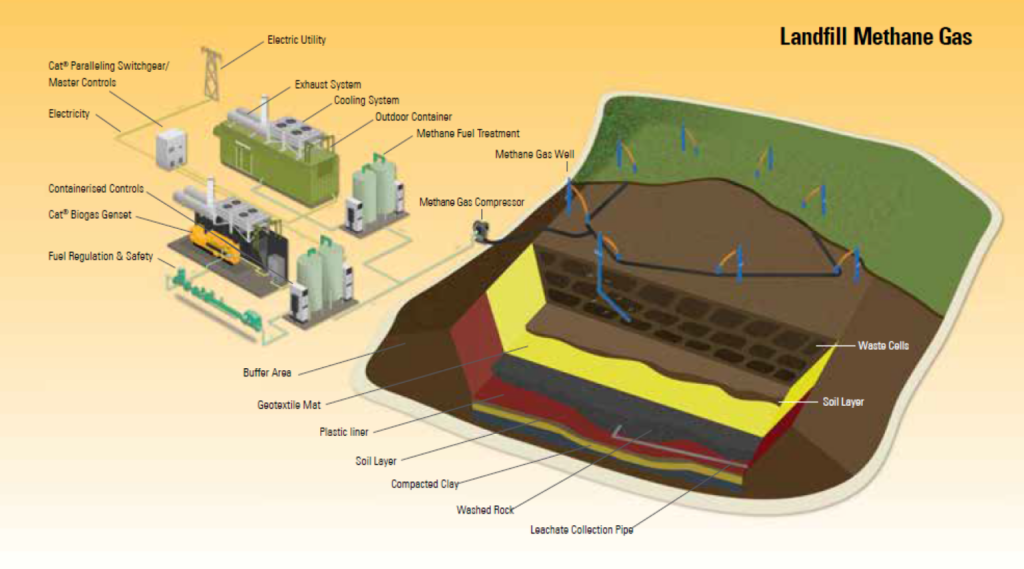
The two energy sources of landfill methane and the Sun may seem unlikely partners for a single power plant to produce enough electricity to power upwards of 1,900 homes for a year in South Australia, but it works.
Copy: In October 2017, a new electricity generation plant was brought online to supply the City of Salisbury, the City of Playford and the Town of Gawler, in South Australia, which is owned and operated by the Northern Adelaide Waste Management Authority (NAWMA).
It has a unique power generation mix, a first for Australia, as it was designed to use a combination of renewable solar energy and landfill gas to produce electricity, situated in an area surrounded by one of NAWMA’s many landfill sites.
Landfill and solar
Landfills usually have no utility beyond allowing the dumping of large amounts of garbage a long way from towns and, once they are full, the land they are in will settle and produce gasses. So a project like this, one that uses the gas emissions, which would otherwise just escape into the atmosphere, makes a lot of renewable sense.
Married to a solar plant, it becomes a hugely important energy source that will never fade, bar equipment replacement and maintenance cycles. This makes a sensible and useful employment of this land, which would otherwise have to be left alone, unless one enters into expensive clean-up operations to make it usable.
One part of this system produces electricity using a 5000 sqm installation of solar panels, generating around 2,000 megawatt-hours of electricity each year, while methane gas emitted from decomposing garbage, the plant’s base-load power, produces about 11,000 megawatt-hours of electricity each year.
A key aspect of this mix is that both the electricity produced from solar PV panels and the gas turbine pass through the same grid interconnector, another first for Australia, producing enough electricity to power about 1,900 local homes.

Solar generation systems on landfills, and adjacent buffer zones, provide for an economically viable reuse for sites that may have significant clean-up costs and little potential for commercial or residential redevelopment. Installing such systems does present a series of unique challenges.
The lead for this project was LMS Energy, Australia’s largest landfill biogas company, whose subsidiary Joule Energy managed the design, installation and commissioning of the plant.
Joule Energy primarily focuses on developing cutting-edge solar power generation solutions, and was the first in developing a solar farm on a landfill project in Australia. As it is an LMS company, it has extensive knowledge and experience in negotiating the always complicated relationship between solar power and landfill methane gas installations. This site actually realises an annual greenhouse gas (GHG) emissions reduction of around 2,000 tonnes of CO2e annually
State-of-the-art power generation
To help plan this installation, Joule Energy called on hybrid power experts from Energy Power Systems Australia (EPSA). The land where the solar farm was to be sited was an unused piece of land around LMS’s Uleybury landfill site to the north of the city of Adelaide, South Australia.
The solution that EPSA presented to Joule was based on CAT’s state-of-the-art power generation and management equipment, together with design, installation, build and commissioning of a 1.15MW photovoltaic (PV) plant.
The basic premise of this site was to generate electricity through two disparate methods:
- The 11,040 Cat® PV panels capture the sun’s energy and convert it to DC power, which in turn is fed through one of their solar inverters that converts it into AC electricity.
- Waste organics in the landfill decompose to release large amounts of methane, which a Cat® biogas generator converts into electricity.
A key issue this combination raised was how to safely merge two sources of generated electrical power before it connected to the local grid. This was overcome by installing an interconnect (with the Cat® gas genset) to receive electricity and send it on downstream.
Green and other achievements of this plant
- 11,000 megawatt-hours per annum of renewable energy
- Power to more than 1,900 homes
- Saving 24 million litres of water each year
- Reduce GHG emissions of around 63,500 tonnes of carbon
- Dynamic stabilisation of the local grid voltage
EPSA is one of the leading companies in Australia planning for and designing renewable energy alternatives. Their aim is for low-, or no GHG, emission power generation, especially as a fair bit of the country is so remote from conurbations. Self-contained designs and solutions, backed by the wide range of world-class equipment and machinery from Cat® power systems, can be formed into turnkey technical solutions that can be installed, and be providing electricity, in a short time.
Another aspect that needs to be considered, especially of Australia’s power grids, is the ever-present possibility of unstable electricity supply. Cat®-based hybrid power generation systems can become an important source of providing that stability, by taking up the slack if/when grid voltage fluctuates.


